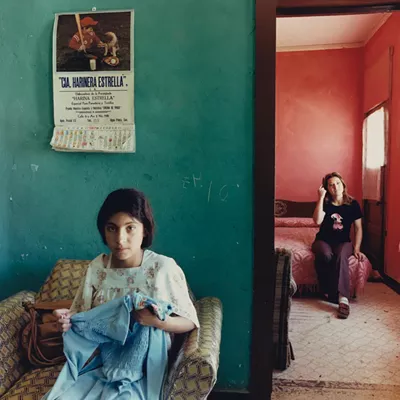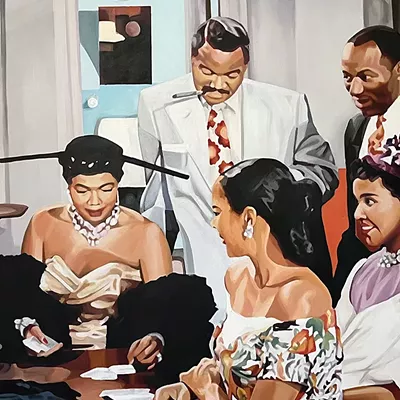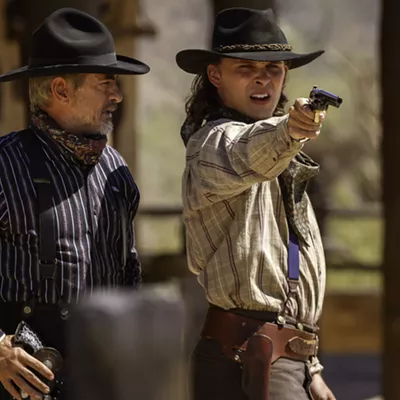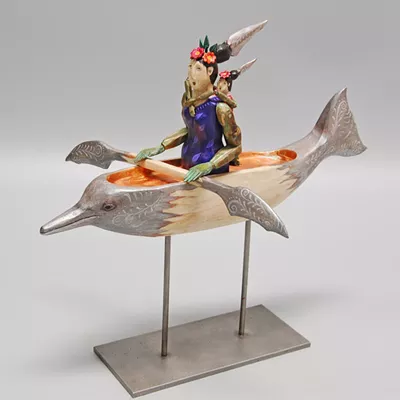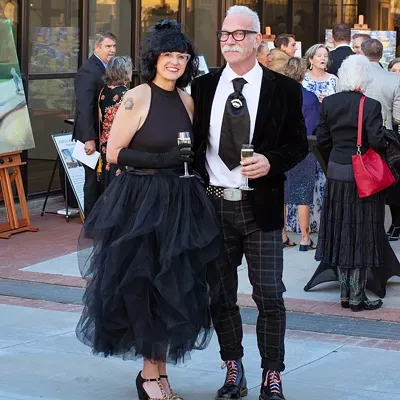Artist Jo Andersen has a wonderfully loose definition of "spire."
Take the Tiki head at The Hut, a bar on Fourth Avenue. The big head traveled down Speedway Boulevard from Magic Carpet Golf in 2008, when the miniature golf course closed down. Now standing tall above The Hut's open-air drinking patio, the Tiki is what one admirer called a "treasure of Polynesian pop."
To Andersen, it's one of this town's iconic sky-soaring structures, and she's honored it in her artist's book "Spires of Tucson II," at Davis Dominguez Gallery.
In this accordion-style book of dreamlike black-and-white photos, the Tiki stands as an equal with the towers at the Fox Tucson Theatre and the former Chinese Confucian Church on Sixth Street, as well as eight other Tucson landmarks.
The white minaret and dome of the Ahmadiyya Muslim Community mosque on West Speedway gets its own page, and so does the Our Savior's Lutheran Church white Spanish-style steeple on Campbell Avenue. My personal favorite, the retro tower at Tucson International Airport, takes pride of place on the cover.
Andersen's marvelous folding book is a highlight of Davis Dominguez's Small Things Considered: 24th Small Works Exhibition. For its celebration of Tucson architecture that's serious and kitschy, sacred and secular—and for its beautifully crafted solar photos—I dub it "Best in Show" in my annual Sizey awards contest.
The Sizeys have been running almost as long as the gallery's small works shows. It's all for fun, and the categories are by turns solid and silly. I don't have to follow any rules, but the artists do. The gallery requires them to meet strict size limits: paintings and other wall works must be 12 inches by 12 inches or less; sculptures cannot exceed 18 inches in height. This year, all but one of the 83 invited artists met the criteria.
Here are the 2016 Sizey winners:
POLITICAL ART AS UGLY AS A POLITICAL CAMPAIGN. Alfred Quiroz routinely paints scathing political art. This year, Donald Trump—he of the small hands and small you-know-what—gets Quiroz'd. Last time, the villain was Sheriff Joe Arpaio. Quiroz's small-scale painting "T-Rumped" cuts the Republican strongman down to size. Naked and repulsive, the tiny Trump lounges in a New York apartment, with a dollar bill strategically shielding a petite penis.
LOVELIEST LANDSCAPE. In a respite from the campaign horrors, Duncan Martin captures the beauty of the West in his "Edge of Light," a lively, brushy oil on panel. A deep blue sky, with a hint of rain, hangs over low mountains rolling across the horizon. Below lies a swathe of glistening ochre desert.
WATER, WATER...NOWHERE. In this disappointing El Niño year, when the rains have not yet come, artists have water on their minds. In "Exhausted Hydrology," Jenny Day has painted the driest of deserts, cut through by a dry irrigation sluice. The distant mountains look parched, and even the sky is drained of color. Day, whose first Tucson show featured paintings of copious Alaskan snow, gets the (Lack of) Water Prize, Painting Division.
Michael Fadel's "Why So Soft?" is an eccentric pedestal sculpture with moving parts and actual dirt from the dry lakebed of the Wilcox Playa. Fadel added water to make mud, and then made the mixture mimic what happens when water dries up: the earth cracks. For Fadel's inventiveness and concern for the endangered waterways east of Tucson (we're looking at you, El Dorado, would-be developer of 28,000 houses near Benson), he wins (Lack of) Water Prize, Sculpture Division.
MOST MAGICAL FAIRY TALE. There's a surprising tug-of-war for this title between two paintings suggesting dark tales about to be told. Monika Rossa's "Night Pasture," a shiny-surfaced mixed media, pictures an elf riding an eerie two-headed cow under an inky sky. Paula Wittner, the Patagonia artist who recently had a magical show in the Museo de Arte de Nogales, contributed "Imposters," an uneasy circus scene in gouache. An evil witch-like figure lurks loiters among a crowd of sweet clowns dressed all in white. Call it a tie.
BEST BIRD. As always, the avian competition is strong. Oil painter Gail Marcus-Orlen has a lovely pair of plump white doves on a shelf in her magical realist still life "Haiku No. 1." But the award goes to DeAnn Melton, who goes into the wild for "Crane Study Red & Blue." Painted loose and free in oils, three cranes show off their graceful curves and their striking colors: gray and white wings, golden breasts, red and white heads.
MOST DRAMATIC STORM. This is another tie, between Debra Salopek, perennial winner of Best Clouds, and Eric Twachtman. Twachtman's mixed-media "Winter Storm, Oracle," captures the angry blue-violet of a tempest breaking over the mountains close to home, while Salopek's Oil "Clearing Storm" records the clouds retreating from a big prairie sky.
BEST MEMORY OF THE TUCSON OF OLD. Photographer Claire Harlan lovingly conjures up a Tucson redolent of the past. The falling-down adobe in her delicately colored, untitled photo might be one of the hardscrabble old ranch houses you can still see along the Rillito. It's got a messy yard with trash strewn and chain link wrapped around a palm tree. A white horse out front, perhaps the last of an old ranch herd, turns and aims its wise old eyes at the viewer.
NAUGHTIEST ARTIST. Danny Perkins of Seattle made a translucent blown-glass shaft that, at 39 inches tall, is more than double the exhibition's 18-inch height limit for sculpture. No matter. Shimmering in red, blue and rose, the tall glass tube is so alluring that the gallery accepted it anyway. Sometimes, in art as in life, it pays not to play by the rules.

